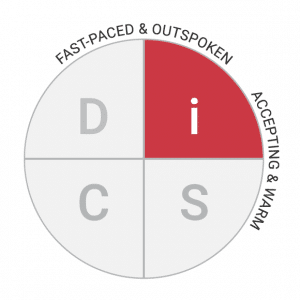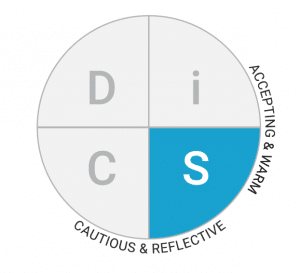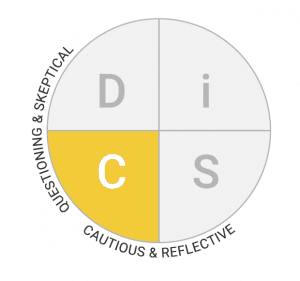We might love to offer our opinions, but giving and receiving feedback in the workplace isn’t always easy. We wonder if it’s really wanted, if it will be accepted, or if it will be acted upon. Will the recipient be thankful, accepting, cold, hostile, or punishing?
The best teams can help each other give honest feedback and even seek out productive conflict. They’ve practiced giving and receiving feedback. They’ve learned to assume positive intent behind feedback and have established a few explicit rules about how it should be delivered. Their feedback is frequent, ongoing, and normal.
A person’s own confidence and cultural background can influence how they prefer to give and receive feedback, even positive feedback. There are feedback suggestions that work for almost all of us, such as watching our body language and asking if someone wants feedback before giving it. A person’s personality type, such as their DiSC® style, also matters.
Each DiSC style has differing goals for and fears around getting feedback. Feedback implies a need for a change of focus, activity, or behavior and can stir up personal fears and insecurities. Most people want to do good work and are accepting of feedback. Here are some tips for giving and receiving feedback in a more targeted and useful way.
“Overall, our research found that people consistently underestimate others’ desire for feedback, which can have harmful results for would-be feedback recipients.”
What if I don’t know someone’s personality type?
The tips in this article are organized by the DiSC style of the person you are interacting with. If your workplace uses DiSC, you’ve got a head start on developing the important soft skills of giving and receiving feedback. If your workplace doesn’t use DiSC, you can still practice people-reading to estimate the DiSC style of your colleagues and adjust your approach to giving and receiving feedback with each person.
Answer these two questions, based on behaviors you can observe:
- Is the person you are giving feedback to more fast-paced/active/bold or more cautious/moderate-paced/calm?
- Is the person more questioning/logic-focused/skeptical or more accepting/people-focused/agreeable?
If they are fast-paced and questioning, refer to the tips for the D style.
If they are fast-paced and accepting, refer to the tips for the i style.
If they are cautious and accepting, refer to the tips for the S style.
If they are cautious and questioning, refer to the tips for the C style.
This kind of people-reading is not a substitute for a full DiSC assessment, and you should always use caution when making assumptions about others. Everyone is a mix of all the DiSC styles, but observing where someone falls on these two scales can help you offer feedback in a manner more likely to be well-received.
Read more: People-reading with Everything DiSC®
How to give feedback to each DiSC style
D styles
Remember: They fear losing control, being taken advantage of
- Be direct and brief.
- Offer suggestions and listen to theirs.
- Ask “what” questions. What are you trying to achieve? What are your plans?
- Show confidence in their abilities.
- Know that they may respond brusquely, but that doesn’t mean necessarily that they are angry or are rejecting your feedback.
- Remember that they enjoy competition and respond well to stretch goals.
- Compliment them directly and immediately.
i styles
Remember: They fear rejection, loss of approval
- Provide feedback in a casual setting.
- Highlight how your suggested changes will benefit them.
- Allow them time to verbalize their thoughts, feelings, and ideas.
- Ask about their motivation for taking an action or making a change.
- Know that they may need to respond emotionally before they can really hear or take action on your feedback.
- Remember that they have a need to express themselves.
- Praise them publicly.
S styles
Remember: They fear losing security, sudden change
- Be specific in your feedback and offer concrete examples.
- Explain how changes will increase stability over the long run.
- Offer to discuss the issue again later to give them time to think.
- Ask if a change in structure or policy would make change easier.
- Know that they may become emotional, so be patient as they process the feedback. They may also need to review your feedback with others before they can accept it.
- Ask for their ideas and give them plenty of time to answer.
- Offer sincere praise in a private setting.
C styles
Remember: They fear criticism of performance, lack of standards
- Review expected results to be sure you’re in alignment. Be specific and factual.
- Ask them how they plan to make changes and what support they’ll need.
- Refer back to agreed-upon standards or best practices.
- Provide them time to think over your feedback and commit to any changes.
- Know that they might have an emotional response, but you probably won’t see it. If you think you might have hurt them, you need to ask.
- Encourage them to help define quality standards.
- Compliment them privately and be specific.
“Feedback is key to personal growth and improvement, and it can fix problems that are otherwise costly to the recipient.”
How to receive feedback from each DiSC style
Good feedback is a gift if it allows us to see through our own blind spots or better understand the consequences of our behaviors on others. We want to show that we’ve heard the feedback and appreciate it. We want to get the most out of it that we can.
Each of us will respond to feedback first from our own style preferences. However, if we can reflect back some of the speaker’s style, our shared experience of the feedback can be richer and more productive.
D styles
Focus on results.
- Accept their bluntness. They aren’t trying to be rude.
- Remain businesslike.
- Ask “what” questions to get at specifics. What exact change is needed? What do you mean? Can you give an example?
- Show your desire to achieve results.
- Provide examples of changes made as a result of their feedback.
i styles
Focus on issues of influence and sociability.
- Show enthusiasm for hearing their suggestions and observations.
- Ask “who” questions. Who will this help/reach? Who will be/has been affected?
- Be informal, casual, and ready to brainstorm ideas.
- Show that you understand their interests and needs. Express your own.
- Thank them for sharing with you.
S styles
Focus on stability and relationships.
- Be methodical and respectful.
- Ask “how” questions. How could this be improved? How do you see this differently?
- Probe for additional task-related specifics or other concerns.
- Ask if you can follow up with them later about changes you’re making.
- Show sincere appreciation for the feedback.
C styles
Focus on quality.
- Be businesslike and respect their knowledge and expertise.
- Ask “why” questions. Why do you think this is wrong? Why do you think a change is needed? Why will that help achieve our goal?
- Offer options.
- Be prepared to back up your choices with data.
- Summarize verbal feedback in writing.
How to decide if you should give feedback
Be sure you’re giving feedback that is valuable. If someone is simply using a different work process—doing it differently than you would—but getting results, then you need to let it go. You might also want to avoid giving feedback in these situations:
- You don’t have enough information or are using secondhand information or gossip.
- The recipient has no control over what you want them to change.
- The person is really vulnerable or emotional right now.
- You don’t have time to engage in dialogue.
- You only have criticism and no suggestions for a solution.
If you’re curious about how to give better feedback during conflict situations and gain more awareness of why you might not always respond well, take the Everything DiSC Productive Conflict assessment and get personalized results.
If your team is struggling with feedback, gossip, or unproductive feedback, we recommend The Five Behaviors Team Development program.





